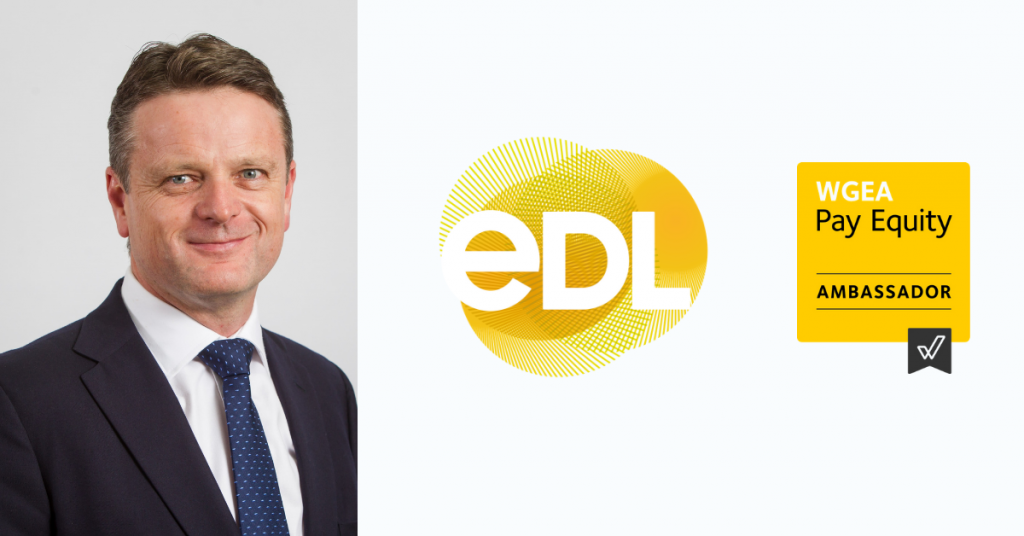“Mr. Harman, my name’s Hollie and I want to work for EDL”
EDL Chief Executive Officer James Harman was appointed as a Pay Equity Ambassador by the Workplace Gender Equality Agency (WGEA) after he voluntarily signed up for its program that encourages equal pay across workplaces. Here, he explains why he took the pay equity pledge.
A few years ago, I was visiting Dapto High School in New South Wales, our partner in the apprenticeship program for our National Maintenance Facility. I was walking down a corridor during a tour of the school when a Year 12 student came running out of class, came straight up to me and said, “Mr. Harman, my name’s Hollie and I want to work for EDL.” I was so impressed by her confidence and determination. She is now a third-year mechanical apprentice for EDL, an invaluable member of the team.
When I joined EDL in 2016, I discovered we had only 13% female employees across our global operations spanning Australia, North America and the United Kingdom. I am a big believer in diversity and inclusion, and it is critical that we be as diverse and inclusive as possible because diverse groups of people make better decisions.
We set up a Global Diversity and Inclusion Committee, which I chair. We thought that gender diversity was a good place to start. Through consultation and alignment, we set a target of 25% female workforce participation by 2023. We are on target to hit that goal. Some people said it wasn’t possible, that it might be achievable in office jobs but not across the company because we have too many blue-collar workers, and so on. We were determined that it was possible, that there were many talented females who hadn’t had the opportunity and had a passion for the operating work that we do.
Equally important is pay equity. It is only right that all people in the company should be treated and remunerated the same for the same role, regardless of their gender. We discovered through a gender pay gap analysis that there were some anomalies, so we fixed them. I started thinking more about pay equity and began to understand some of the causes of gender gaps in pay, primarily around opportunity. If two people are doing the same job, I was determined to ensure they are paid the same regardless of gender, culture or anything else.
That is what led me to my decision to champion the cause in a more official way, as a reflection of what we’re doing at EDL and what I believe in, my own values. So, I signed the Workplace Gender Equality Agency’s Pay Equity Pledge and will be working with the agency as a Pay Equity Ambassador.
Looking ahead as a Pay Equity Ambassador, our people can expect me to be vocal about pay equity in terms of testing and reporting how we’re performing. EDL will also continue to provide opportunities for women to advance their careers at all levels of the company. This is important, because our analysis indicated an overall higher concentration of women in lower-paying roles and an under-representation of women in more senior roles.
We have also rethought the way we advertise for roles, and our jobs ads now reflect this new approach. For example, in the past we were very specific about operational roles, saying, “We want people who have experience on this type of engine, at this type of power station, in this type of region”. But recently, we’ve had far more success getting women to apply for these jobs by saying something like, “If you are a qualified electrician and are interested in working in our type of power station, we want to talk to you.” It is about the skill set and potential, rather than specific experience. This is backed up by research that shows that often females won’t apply for a role if they don’t believe they fulfill all the criteria, whereas males are more likely to say they can do it all.
To CEOs who see female participation and pay equity problems in their organisation, but haven’t yet acted, I say: just do it. As CEO, you can drive change by showing that such an initiative is part of your own personal values. Achieve alignment and consult with your people. Listen and respond to the concerns and questions you will inevitably hear, particularly from some older male employees who might feel they are being discriminated against.
At EDL, we didn’t make the change overnight. But by doing it methodically, with the buy-in and ownership of our people, it is now ingrained in our culture. Diversity and inclusion is the right thing to do, and it is also the best thing to do for our business.
Pictured above: James Harman (third from right) with members of EDL’s engineering team (from left) Brenton Wendt, Berrin Gokce, Rebekah Utting, Shane Fitzsimmons and Lisa Bradshaw

